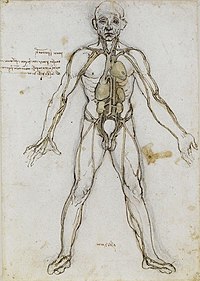 |
| Part of a series of lists about |
| Human anatomy |
|---|
| General |
| Structures |
| Muscles |
| See also |
In anatomy, flexor is a muscle that contracts to perform flexion (from the Latin verb flectere, to bend), a movement that decreases the angle between the bones converging at a joint. For example, one's elbow joint flexes when one brings their hand closer to the shoulder, thus decreasing the angle between the upper arm and the forearm.
Flexors
Upper limb
- of the humerus bone (the bone in the upper arm) at the shoulder
- of the forearm at the elbow
- of carpus (the carpal bones) at the wrist
- of the hand
Lower limb
Hip

The hip flexors are (in descending order of importance to the action of flexing the hip joint):
- Collectively known as the iliopsoas or inner hip muscles:
- Anterior compartment of thigh
- Rectus femoris (part of the quadriceps muscle group)
- Sartorius
- One of the gluteal muscles:
- Medial compartment of thigh
Without the iliopsoas muscles, flexion in sitting position is not possible across the horizontal plane.
Thigh
Other
See also
This article uses anatomical terminology.References
- Anderson, Kenneth N.; et al., eds. (1994). Mosby's Medical, Nursing, & Allied Health Dictionary (4th ed.). St. Louis: Mosby-Year Book. p. 624. ISBN 9780801672255. OCLC 312496360.
- ^ Platzer (2004), p 246
- Knee Articulations
- Foot Articulations
| Joints | |
|---|---|
| Types |
|
| Terminology | |
| Motions |
|
| Components | |